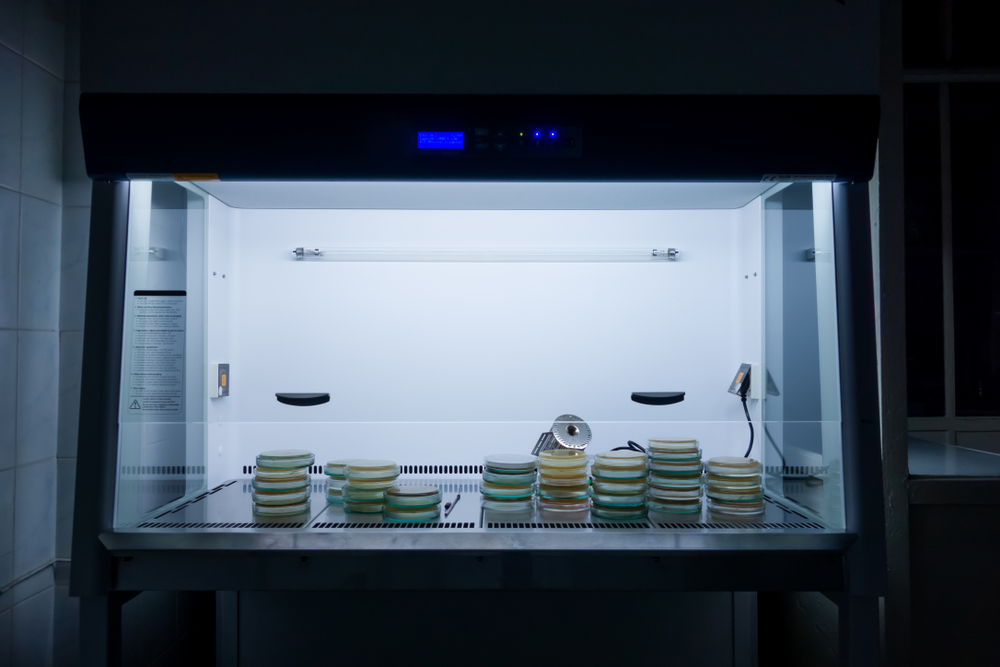
In the realm of lab safety, few pieces of equipment are as critical as the fume hood. Serving as the frontline defense against hazardous fumes, vapors, and dusts, laboratory fume hood design is crucial as they play an indispensable role in safeguarding the well-being of researchers, technicians, and the environment.
However, the effectiveness of these vital tools hinges not only on their design but also on the adherence to best practices for their safe and proper use.
In this article, we delve into the intricacies of laboratory fume hood design, exploring the key components, various types, and crucial safety considerations that underpin their functionality and sustainability, helping a lab meet various requirements.
By decoding the principles of hood design and shedding light on the best practices for their utilization, we aim to empower laboratory personnel with the knowledge and tools necessary to enhance safety within their workspaces.
What are the Functions of a Fume Hood?
Fume hoods serve several critical functions in laboratory environments, primarily aimed at protecting personnel from exposure to hazardous substances. They effectively capture and contain harmful fumes, vapors, and dust generated during experiments, preventing them from dispersing into the laboratory air.
By maintaining a controlled airflow, fume hoods draw contaminated air away from the user and exhaust it safely outside the building or through appropriate filtration systems. Additionally, they provide a physical barrier between the user and potentially dangerous reactions, enhancing overall laboratory safety.
Through these mechanisms, fume hoods help ensure a safe and compliant workspace, enabling researchers to conduct their work with reduced risk of exposure to toxic or volatile chemicals.
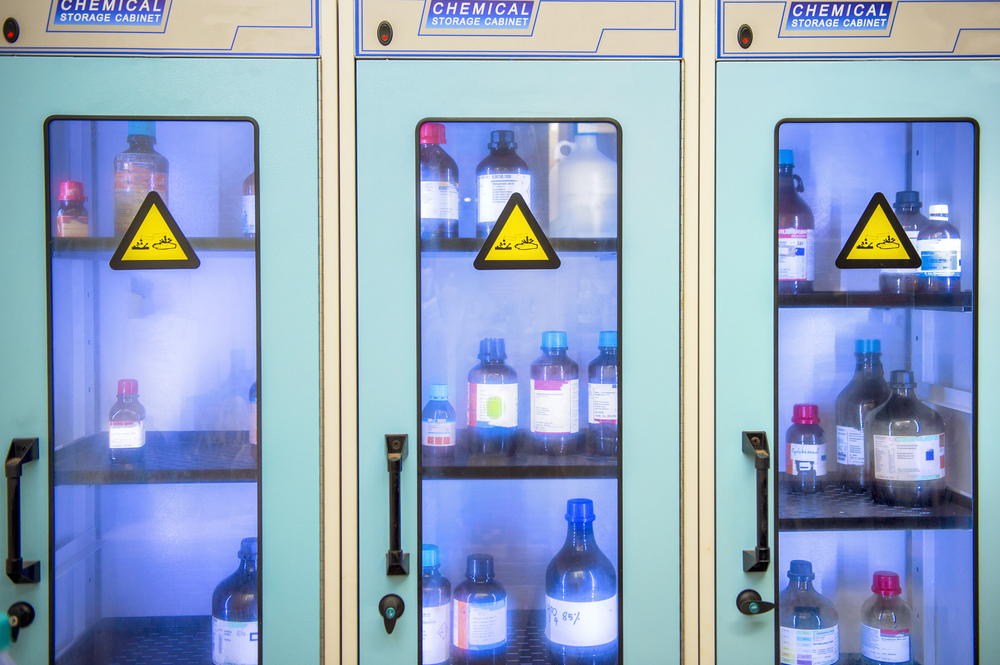
Fume Hood Design — Materials Used
Laboratory fume hoods are made of materials that are resistant to the chemicals and substances used in the laboratory. The choice of materials ensures durability, safety, and ease of cleaning. Common materials used in the construction of fume hoods include:
— Stainless Steel
Known for its durability and resistance to corrosion, stainless steel is often used for the structural frame, work surfaces, and interior lining of fume hoods. It can withstand exposure to a wide range of chemicals and is easy to clean.
— Polypropylene
This thermoplastic is resistant to various chemicals, including acids and bases. Polypropylene is often used for fume hoods that handle particularly corrosive substances. It is lightweight and non-conductive, making it suitable for certain applications.
— Epoxy Resin
Epoxy resin is commonly used for work surfaces and linings inside fume hoods due to its excellent chemical resistance and durability. It can withstand spills and exposure to harsh chemicals without degrading.
— PVC (Polyvinyl Chloride)
PVC is another material used for constructing certain parts of fume hoods, particularly ductwork and exhaust systems. It is resistant to chemical corrosion and is relatively inexpensive.
— Tempered Glass
The sash or front window of a fume hood is typically made from tempered glass. This material provides clear visibility into the hood while offering strength and safety in case of breakage.
— Fiberglass-Reinforced Plastic (FRP)
FRP combines the chemical resistance of plastics with the strength of fiberglass, making it a suitable material for certain fume hood applications, especially where structural strength and chemical resistance are both required.
Each of these materials offers specific benefits and is chosen based on the type of work being conducted in the fume hood, the chemicals used, and the desired durability and maintenance requirements.

Laboratory Fume Hood Components
Laboratory fume hoods consist of several key components, each playing a crucial role in ensuring the effective and safe operation of the hood. Here are the main components:
1. Hood Body Exterior
The main enclosure that contains the work area where experiments are conducted. It is usually made of painted steel. Some hood exteriors are made of stainless steel, polypropylene, wood, or phenolic resin. The exterior of the work chamber is an important design element for fume containment. Properly designed laboratory fume hoods will have a contoured entry at the face of the hood, which assists airflow into the hood and could improve hood performance.
2. Hood Body Interior
The area inside the hood where experiments and procedures are carried out. The work surface should have a recessed, or dished area that is designed to provide containment of small spills and splashes. The work surface is typically made of materials resistant to chemical fumes, vapors, and condensation particulate that may collect and deposit on the interior surface of the fume chamber such as epoxy resin or stainless steel.
3. Sash
A movable, transparent window at the front of the hood, usually made of tempered glass or safety glass. The hood sash could move vertically, horizontally, or both. The sash can be raised or lowered to provide access to the work area while acting as a physical barrier between the user and hazardous substances and air contaminants.
4. Baffles
Panels located at the back of the hood that help direct the airflow. Baffles ensure that air is evenly distributed across the work surface and prevent the formation of dead zones where contaminants could accumulate.
5. Airfoil
A streamlined edge at the hood face that helps maintain smooth airflow into the hood. The airfoil minimizes turbulence and enhances the efficiency of the hood.
6. Exhaust System
A critical component, attached to the hood by an exhaust collar, removes contaminated air from the hood and expels it outside the laboratory. The exhaust system typically includes ductwork, an exhaust fan, and sometimes filters to capture specific contaminants.
7. Lighting
Integrated lighting fixtures inside the hood provide adequate illumination for the work area. These lights are typically shielded to protect them from chemical exposure.
8. Control Panel
A user interface housed near the hood opening but outside the hood chamber that allows for the operation and monitoring of the fume hood. The control panel may include switches for lights, fans, and alarms, as well as airflow monitors.
9. Airflow Monitor and Alarm
A device that measures the airflow through the hood and alerts users if the airflow falls below safe levels. This ensures that the hood is functioning correctly and maintaining a safe environment.
10. Sash Stop and Sash Sensor
The sash stop limits the height to which the sash can be raised, ensuring optimal airflow and safety. The sash sensor detects the position of the sash and can trigger alarms or adjust airflow accordingly.
11. Ductwork
The network of ducts that carries exhaust air from the hood to the outside of the building. Ductwork materials are chosen for their resistance to the chemicals used in the lab.
12. Filter (optional)
Some fume hoods are equipped with filters, such as HEPA filters for particulates or activated carbon filters for chemical vapors, to capture contaminants before the air is exhausted.
13. Face Velocity Indicator
A gauge that measures the speed of air entering the hood through the sash opening. Proper face velocity is essential for the effective containment of contaminants.
Each of these components plays an integral role in the safe and effective operation of laboratory fume hoods, ensuring that hazardous fumes and vapors are contained and safely removed from the laboratory environment.
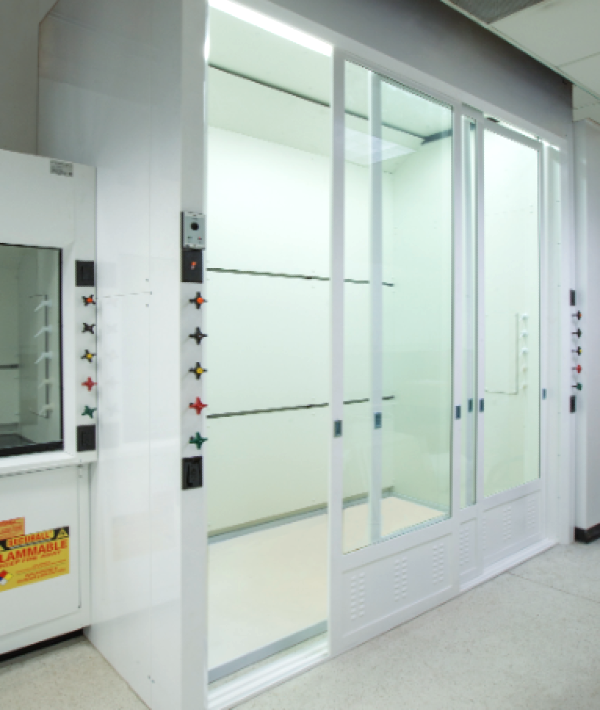
Different Types of Fume Hoods
There are several different types of fume hoods, each designed for specific applications and types of laboratory work. Here are the main types of fume hoods:
1. Conventional Fume Hoods
The most basic type of fume hood, which uses a constant volume of air to draw fumes away from the work area. The airflow rate remains constant regardless of the sash position.
2. Bypass Fume Hoods
These hoods have a bypass opening that allows air to enter even when the sash is closed, maintaining a more constant airflow and preventing high face velocities that can compromise safety and containment.
3. Variable Air Volume (VAV) Fume Hoods
VAV hoods adjust the volume of air exhausted, based on the sash position. When the sash is lowered, the airflow decreases, saving energy while maintaining appropriate face velocities.
4. Auxiliary Air Fume Hoods
These hoods use a dedicated supply of external air to supplement the room air being exhausted, reducing the impact on the lab’s HVAC system and improving energy efficiency.
5. Ductless Fume Hoods
Equipped with filters that capture hazardous fumes and vapors before recirculating clean air back into the laboratory. These hoods do not require ductwork, making them more flexible and easier to install.
6. Perchloric Acid Fume Hoods
Specifically designed for work with perchloric acid, these hoods have a wash-down system to prevent the buildup of explosive perchlorate crystals in the ductwork.
7. Radioisotope Fume Hoods
Designed for handling radioactive materials, these hoods are typically constructed with type 304 stainless steel for easy decontamination and may include lead shielding for radiation protection.
8. Acid Digestion Fume Hoods
Built to handle highly corrosive acids used in digestion procedures, these hoods are typically lined with acid-resistant materials such as polypropylene or PVC.
9. ADA-Compliant Fume Hoods
Designed to be accessible to users with disabilities, these hoods have features such as adjustable height work surfaces and controls positioned within easy reach.
10. Walk-In Fume Hoods
Large, floor-mounted hoods that allow users to walk into the hood for working with bulky equipment or large-scale experiments. They are often used for storage of containers that pose some hazard, but will not fit into an approved storage cabinet.
11. Canopy Hoods
Mounted above work areas like hot plates or small ovens, these hoods capture and exhaust heat, steam, and fumes. They are open on the bottom and are not typically used for highly hazardous substances.
12. Distillation Fume Hood
A distillation fume hood is designed with a greater interior height for use with tall apparatus.
13. Bench-Top Fume Hoods
Standard hoods mounted on laboratory benches, used for various general-purpose applications. They are versatile and commonly found in many laboratories.
Each type of fume hood is designed to meet specific requirements and provide safe and effective containment for various laboratory applications. The choice of fume hood depends on the nature of the work, the types of chemicals used, and the specific safety needs of the laboratory.
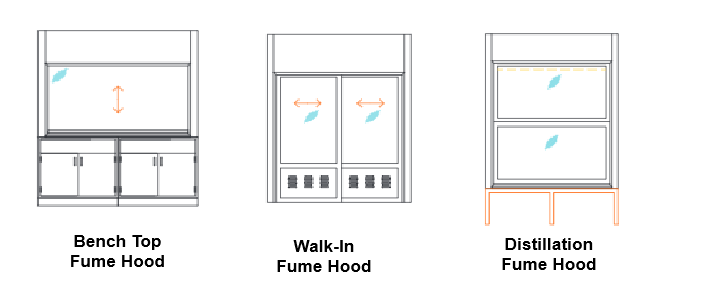
Additional Reading: Clinical Laboratory Construction: Building for the Future of Medicine
Location of Fume Hoods in a Laboratory
When locating fume hoods in laboratories, several safety considerations must be taken into account to ensure optimal performance and protection for users. Here are key safety considerations for the placement of fume hoods:
— Away from High Traffic Areas
Fume hoods should be placed away from doors, windows, and high foot traffic areas to minimize disturbances to the airflow, which can compromise containment and reduce the effectiveness of the hood.
— Adequate Ventilation
Ensure that the fume hood is located in an area with adequate ventilation and that the laboratory’s HVAC system can handle the additional air exhausted by the hood. Proper ventilation helps maintain safe air quality and prevents the recirculation of hazardous fumes.
— Sufficient Space
Allow enough space around the fume hood for safe and convenient access. There should be adequate clearance on all sides to facilitate maintenance and ensure that users can work comfortably without obstruction.
— Avoid Cross Drafts
Position the fume hood away from air supply vents, fans, and other sources of cross drafts that can disrupt the airflow and reduce the hood’s containment efficiency.
— Accessibility
The hood should be easily accessible to all users, including those with disabilities. Consider ADA-compliant designs that offer adjustable heights and controls within easy reach.
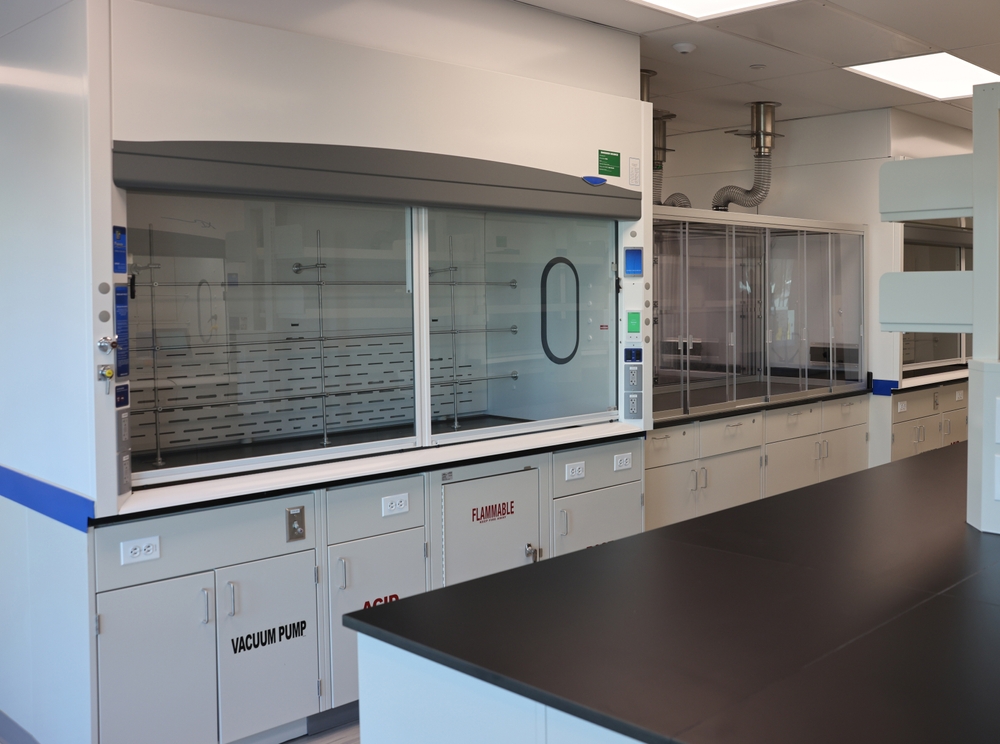
— Proximity to Work Area
Locate the fume hood close to the primary work area where hazardous chemicals and procedures are frequently used. This minimizes the distance that potentially dangerous materials need to be transported.
— Emergency Equipment
Ensure that safety equipment, such as emergency eyewash stations, safety showers, and fire extinguishers, is easily accessible from the fume hood location. Quick access to these facilities is crucial in case of an emergency.
— Electrical and Plumbing Services
Position the fume hood where necessary services such as electricity, water, and gas can be easily connected. Ensure that these utilities are properly installed and meet safety codes.
— Exhaust Duct Routing
Plan the fume hood location to allow for efficient and safe routing of exhaust ducts. The ducts should have minimal bends and be as short as possible to reduce resistance and improve exhaust efficiency. Ensure that the exhaust outlet is located away from air intakes and building occupants.
— Noise Levels
Consider the noise generated by the fume hood’s exhaust fan and its impact on the laboratory environment. Locate the hood where noise levels will not interfere with other activities or communication within the lab.
— Seismic Safety
In areas prone to earthquakes, ensure that the fume hood is securely anchored and that any heavy equipment within the hood is properly restrained to prevent tipping or movement during seismic events.
— Regulatory Compliance
Verify that the fume hood location complies with local building codes, occupational safety regulations, and industry standards such as ANSI/ASHRAE 110 and NFPA 45. Compliance ensures that the hood is installed and operated safely and effectively.
By considering these factors, laboratories can ensure that their fume hoods are located in positions that maximize safety, functionality, and efficiency, providing a safer working environment for all laboratory personnel.
Safe Laboratory Practices when Using Fume Hoods
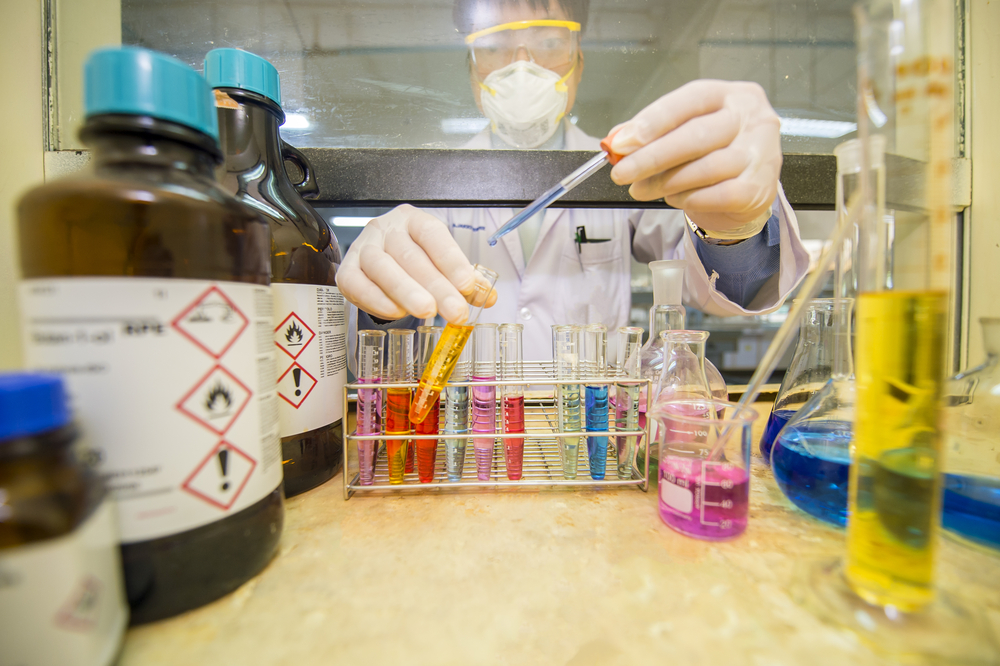
Using a laboratory fume hood safely is essential to protect laboratory personnel from exposure to hazardous chemicals and fumes. Here are some best safety practices to follow when using a laboratory fume hood:
1. Wear Personal Protective Equipment (PPE)
Always wear appropriate PPE, including safety goggles, lab coats, gloves, and respiratory protection if necessary, when working with hazardous materials inside the fume hood.
2. Inspect the Hood
Before use, conduct a risk assessment by inspecting the fume hood for any signs of damage, such as cracks in the glass or dents in the body. Ensure that the sash operates smoothly and that the airflow indicators are functioning properly.
3. Use Appropriate Ventilation
Ensure that the fume hood is connected to an appropriate exhaust system and that the airflow is sufficient to capture and remove hazardous fumes. Do not obstruct or block exhaust ducts.
4. Minimize Clutter
Keep the work area inside the fume hood clear of unnecessary items to maintain proper airflow and visibility. Clutter can disrupt airflow patterns and increase the risk of spills or accidents.
5. Work at the Proper Height
Position equipment and materials at the appropriate height within the fume hood to ensure effective containment and minimize exposure to hazardous fumes.
6. Use Chemical Resistant Materials
Use containers, equipment, and materials that are compatible with the chemicals being used inside the fume hood. Never place sparking or ignition sources inside the hood when flammable liquids or gases are present. Avoid using glassware that is cracked or damaged.
7. Avoid Disturbing Airflow
Minimize movements and disturbances that could disrupt the airflow inside the fume hood. Avoid reaching over the sash or blocking the baffles to maintain proper containment.
8. Monitor Face Velocity
Check the face velocity of the airflow regularly using a face velocity meter or indicator. Ensure that the face velocity is within the recommended range specified by the manufacturer for effective containment.
9. Close the Sash
Keep the sash of the fume hood closed as much as possible during experiments to maintain proper containment and airflow. Only open the sash to the necessary height for conducting experiments, and close it when finished.
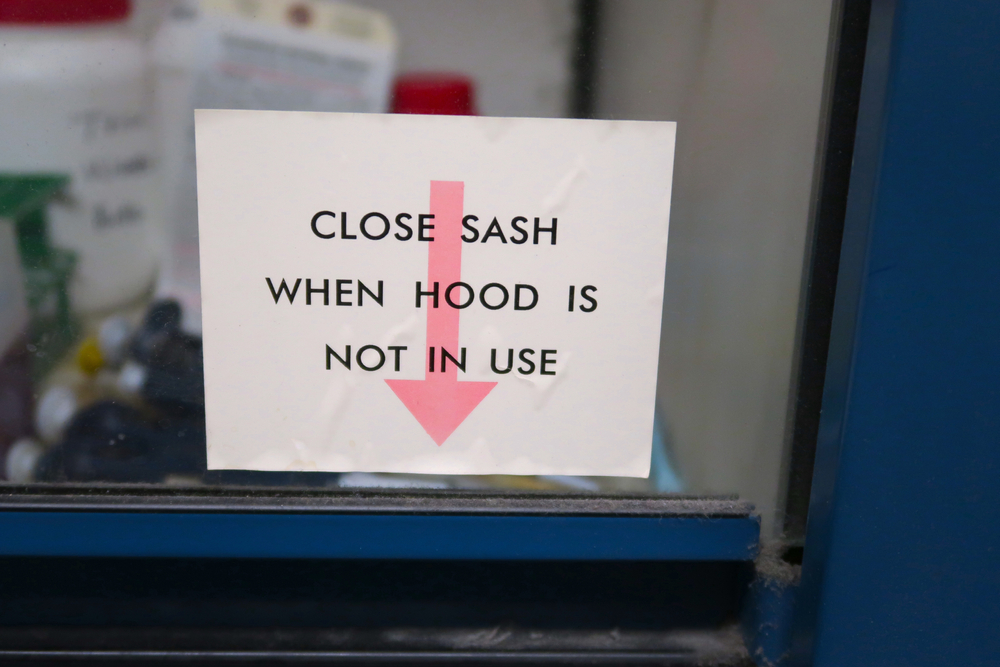
10. Handle Laboratory Chemicals Safely
Follow proper procedures for handling, transferring, and disposing of chemicals inside the fume hood. Use spill trays or secondary containment to contain spills and prevent them from reaching the work surface.
11. Monitor for Contaminants
Be vigilant for any signs of chemical spills, leaks, or odors inside the fume hood. If a spill occurs, clean it up promptly and report any malfunctions or issues with the hood to laboratory personnel or maintenance staff.
12. Training and Supervision
Ensure that all laboratory workers using the fume hood are properly trained in its operation and safe work practices. Provide supervision and guidance as needed, especially for inexperienced users.
By following these safety practices within the lab space, laboratory personnel can effectively minimize the risk of exposure to hazardous chemicals and ensure the safe operation of laboratory fume hoods.
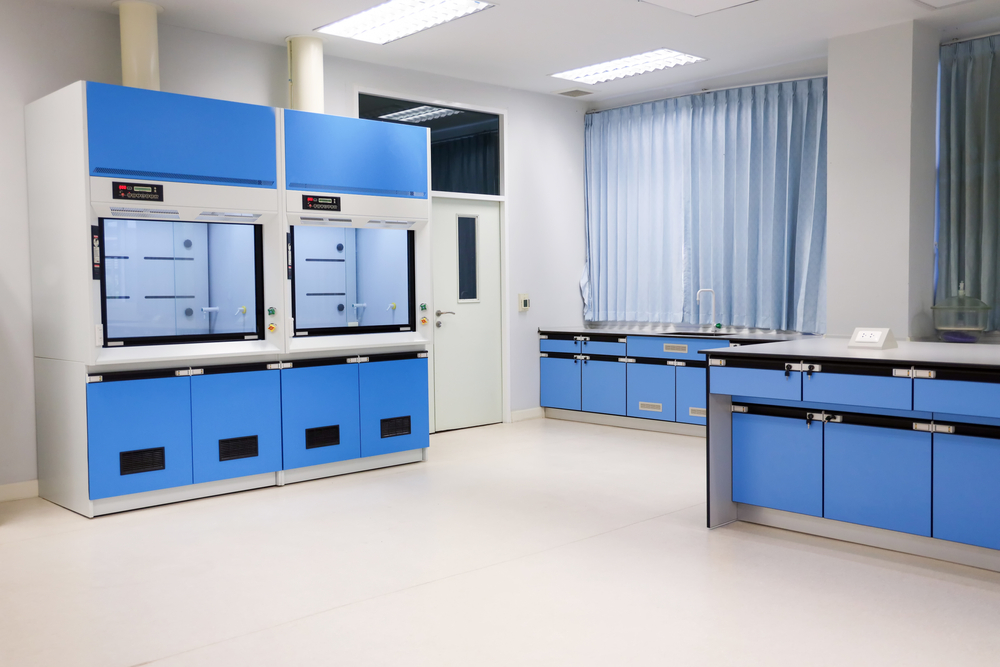
Selecting a Fume Hood Provider
Selecting a reliable fume hood supplier is crucial for ensuring the maximum level of protection, safety, and efficiency of your laboratory, regardless of whether it is a new lab or replacing fume hoods. When choosing a laboratory equipment supplier, look for one that is a member of the Scientific Equipment and Furniture Association (SEFA), as this affiliation signifies a commitment to high industry standards and best practices.
Additionally, ensure that the fume hoods they offer are UL 185 listed, indicating they meet stringent safety and performance criteria, and ASHRAE 110 tested, which confirms their efficacy in containing hazardous fumes.
Moreover, it is essential that the fume hoods comply with and exceed the ventilation requirements set forth by the Occupational Safety and Health Administration (OSHA), guaranteeing a safe working environment by adhering to federal safety regulations.
By prioritizing these qualifications, you can be confident in selecting a fume hood supplier that delivers top-tier, compliant, and reliable safety equipment for your laboratory.
Related Reading: How to Find High-Quality Used Laboratory Furniture
Conclusion
In the dynamic landscape of laboratory safety, the importance of fume hoods cannot be overstated. As stalwart guardians against the perils of hazardous substances, these devices serve as indispensable allies in the pursuit of safe scientific inquiry.
By adhering to best practices for their design, installation, and operation, laboratories can mitigate risks, protect personnel, and uphold the integrity of their research endeavors.
As we navigate the complexities of modern science, let us remain steadfast in our commitment to safety, recognizing the pivotal role that laboratory fume hoods play in shaping a secure and sustainable research environment.
Through continuous education, vigilant oversight, and unwavering dedication to excellence, we can forge a future where laboratory safety is not just a priority but a cornerstone of scientific progress.




